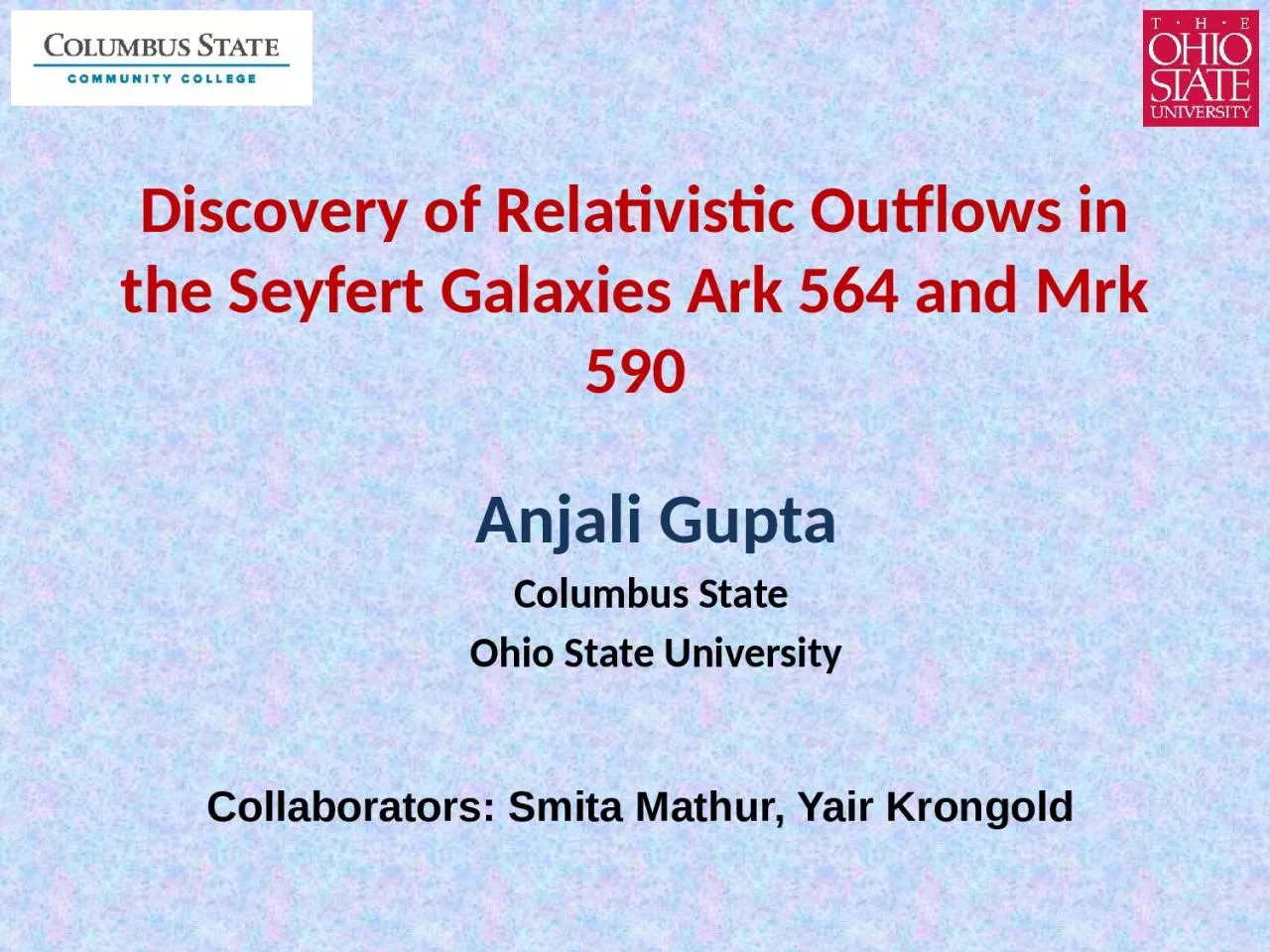

Seyfert Galaxies Ark 564 and Mrk 590 Anjali Gupta Columbus State Ohio State University Collaborators Smita Mathur Yair Krongold Low velocity outflows are ubiquitous ID: 932577
Download Presentation The PPT/PDF document "Discovery of Relativistic Outflows in th..." is the property of its rightful owner. Permission is granted to download and print the materials on this web site for personal, non-commercial use only, and to display it on your personal computer provided you do not modify the materials and that you retain all copyright notices contained in the materials. By downloading content from our website, you accept the terms of this agreement.
Slide1
Discovery of Relativistic Outflows in the Seyfert Galaxies Ark 564 and Mrk 590
Anjali GuptaColumbus State Ohio State University
Collaborators: Smita Mathur, Yair Krongold
Slide2Low velocity outflows are ubiquitous Seen in 50% of Seyfert galaxies.
NGC 3783 HST and FUSE
Slide3Warm Absorbers Krongold
et al. 2003
Log ξ = 0 – 2 erg s-1NH
= 10
20 - 10
22
cm
-2
Outflow Velocity
100 – 1000 km s
-1
Slide4Warm AbsorbersLIP: a low ionization parameter component, Fe UTA, UV linesHIP: a high ionization parameter component, seen only in X-raysIn pressure equilibriumNot efficient agents of feedback
Krongold et al.2003, 2007; Netzer et al. 2003
Slide5Discovery of UFOsIn PG1211+143: Pounds et al. 2003
Slide6Tombesi et al. 2010UFOs
Log ξ
= 3 – 6 erg s-1NH = 1022
- 10
24 cm
-2
Outflow Velocity
0.1c – 0.3c
Slide7Kinetic Luminosity From Tombesi
et al. 2013UFOs Warm Absorbers
Slide8Issues with detected UFOsIdentified through blueshifted FeXXV and/or FeXXVI absorption lines only
All in low resolution CCD spectra. Low significance absorption lines.
Parameterization of the photoionized plasma becomes difficult
Slide9Discovery of Relativistic Outflows in the Seyfert Galaxies Ark 564 and Mrk 590
Gupta et al. 2013; 2014
Slide10Low-velocity outflow in Ark 564
Slide11Discovery of relativistic outflow in Ark 564
Velocity = 0.1c
Slide12Slide13….well fit with photoionization modelLog
ξ = 1.25/0.65 erg s-1
NH = 1019.8/1020
cm-2
Outflow Velocity
0.105c/0.103c
Slide14Two component photoionization model
Slide15Relativistic outflow in Mrk 590V = 0.081c - 0.176c
Slide16….and its photoionization modelHV-LIP
Log ξ = 2.24 erg s-1
NH = 1020.94 cm-2
Outflow Velocity = 0.176c
HV-HIP
Log
ξ
= 4.5 erg s
-1
N
H
= 10
23.5
cm
-2
Outflow Velocity
=
0.0867c/0.0738c
Slide17Kinetic Luminosity of Relativistic Outflows
HV-HIP
Kinetic luminosity
>
10
44
erg/s
c.f. X-ray luminosity: 7.0 x 10
42
erg/s
HV-LIP
Kinetic luminosity > 10
41
erg/s
Slide18This IS a remarkable discovery!Relativistic outflows known only in luminous quasars -- BALQSOs in UV -- Few in hard X-rays: Fe lineFirst example in soft X-rays: Robust! -- better instrumental response
-- multiple lines at the same velocityPhysical parameters well determined.
Slide19…..WA and UFO connection ?
Slide20Disk-wind models of AGNsProga & Kallan 2004
Slide21….unlike other AGN outflows
Slide22What is the driving mechanism?Radiation pressure doesn’t workMagneto-hydrodynamics?Failed jets?
New PhysicsThank You
Slide23Theoretical ModelsKing (2012) shock wind models produce winds with velocities v∼0.1c, but in quasars accreting at Eddington limits. In this model a high velocity ionized outflow collides with the ISM of the host galaxy, losing much of its energy by efficient cooling resulting in a strongly shocked gas.The magneto-hydrodynamic accretion-disk wind models of
Fukumura et al. (2010a;b) predict high-velocity (vout≤0.6c) outflows. These models, how-ever, explain only the high-ionization high-velocity outflows, similar tothose observed byTombesi
et al. (2012). In these models, ultra-high velocities are produced when UV to X-ray spectral slope is steep (αOX≤ −2), i.e. the AGNs are relatively UV bright (or X-ray faint).
Slide24What is the distance of the absorber from the nucleus?Proposals span a factor of > 106 from accretion disk to Kpc scale
narrow line regionn R2
Slide25VariabilityDensity
Distance
Slide26XMM Observations of NGC 4051RGS High resolution spectrumEPIC Variability
Krongold et al. 2007
Slide27Kinetic power released: ~1038 erg/sc.f. bolometric luminosity: 2.5 x 1043 erg/s
Energy injection rate in the surrounding medium is significantly smaller than that in feedback models
ScannapiecoSilkEnergy outflow rates